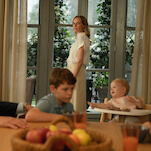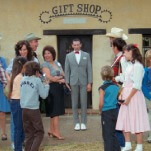Readers agree that the world of The Witcher 3 is harsh, but just how harsh is it?
Tone Up
In his review of The Witcher 3: Wild Hunt, Patrick Lee tried to figure out how the game manages to remain cohesive and intimate despite the massive scope and density of its fantasy world. He argued that the answer is in its dedication to a consistent hostility, a tone that permeates every facet of the game. ComradePig read that ugliness another way:
One thing I will say about the tone is that outside of a handful of moments, it feels more melancholy to me than ugly. The subdued exploration music and scattered battlefields go a long way toward that end, and there’s a general atmosphere of tragedy hanging over the world that is rarely gratuitous. (And while we’re comparing the game’s landscapes to art, I get a very Alexei Savrasov vibe from them.)
That and while the game is unquestionably filled with all manner of thieving assholes, liars and fanatical brutes, it’s not something pointlessly nihilistic like Grand Theft Auto V where the ultimate lesson is that everyone sucks. You meet a lot of genuinely good people on your travels, many of whom are being put through the ringer by the ongoing war and the little bastions of warmth they provide you feel earned.
This being said, I love that my general “be good to everyone and everything” way of usually playing RPGs is not always rewarded. Some characters will use your good will and make you into a sucker for it, and it’s refreshing that you actually have to assess who to trust and why rather than simply press the “be a good person” button.
And CrankyKong agreed that it’s often unpleasant but drew a different parallel:
The tone is ugly, but I found it less the ugliness of a Game Of Thrones and more the implied ugliness of classic fairy tales. The game even frequently references them. It does have a remarkable consistency with its unpleasantness, but it’s politics are all over the place. Women (especially sorceresses) have a huge role to play politically and militarily, but you also fight monsters that are basically aborted fetuses that haunt their parents until they kill them. And the dancers at the bars are referred to as strumpets or, more horrifying, captives depending on the area you’re in. And it doesn’t hurt that basically every model of a female in the game is gorgeous while every male looks like some variation of Cletus The Slack-Jawed Yokel.
Y Can’t Metroid Talk
Zack Handlen broke down the Metroid series and found that its best entries are the ones that allow Samus’ personal narrative to mirror that of the people controlling her—“from relative helplessness to mastery.” A part of that is letting Samus remain an somewhat empty vessel of a character. George_Liquor, though, figures there’s still room to broaden her out:
All too often, Nintendo’s characters suffer from Indiana Jones syndrome: They’re appreciated more for their iconic looks than any character traits they possess. Case in point: Link. He’s literally a different person in nearly every Zelda game, yet we’d hardly know it once he dons the green tunic and goes about the business of being the prophesized savior of Hyrule or whatever. We don’t mind because nothing has ever defined him as a character with a personality. Samus certainly has an iconic look too, but at least she’s the same person in every game. The potential is still there to develop her into something more than a mute avatar for the player.
Elsewhere, discussion turned toward Metroid Fusion, which Zack brought up as an example of a game that retreated from the lack of guidance in the successful Metroid formula. ErikPeter weighed in on its tighter structure:






![HBO teases new Euphoria, Larry David, and much more in 2026 sizzle reel [Updated]](https://img.pastemagazine.com/wp-content/avuploads/2025/12/12100344/MixCollage-12-Dec-2025-09-56-AM-9137.jpg)

































